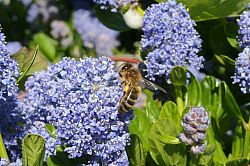Here we take a closer look at several different behaviours commonly seen in a colony of honey bees.
 Honey bee on Ceanothus
Honey bee on Ceanothus
First of all let's see how a honey bee queen lays an egg in an empty cell already prepared by the workers.A good queen of quality stock, well reared with good nutrition and well mated, can lay about 2,000 eggs per day during the spring build-up and live for two or more years.
Note how the queen first examines the cell to see if it is clean and empty, and checks the size, in this case a worker cell, before turning around and inserting her abdomen to lay an egg.
At some point during the worker honey bee's life, she will take up the role of nest guard. Guarding is necessary to protect the hive against predation, parasitism and robbing. Here we see a wasp, Vespula vulgaris, attempting to enter the hive and the fierce response of the guard bees.
The queen bee is cleaned by her courtiers, who meet her every need, including the disposal of her waste. At the height of the season she lays her own weight in eggs every couple of hours, and so is continuously surrounded by young worker attendants, who feed her royal jelly. These attendants lick her body, taking up the queen odour (Queen Mandibular Pheromone), which is then spread throughout the colony via continuous food exchanges between the workers.
Swarming is a natural method of reproduction, where the old queen leaves with a large proportion of her offsping from the original hive to form a new colony. The swarm has to hurry as the only provisions for the journey are in the form of full crops. Once the scout bees, up to 300 workers, have found an ideal site,it doesn't take long for the rest of the swarm (perhaps 20,000 bees) to fly off to the new location. The time taken here from the first bees take off until the last bee leaves is approximately 1 minute 40 seconds.


